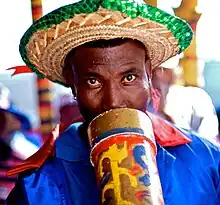Vaccine (instrument)
Vaccine[1][2] (or sometimes vaksin[3][4][5]) are rudimentary single-note trumpets found in Haiti and, to a lesser extent, the Dominican Republic[6] as well as Jamaica.[5] They consist of a simple tube, usually bamboo, with a mouthpiece at one end.

They are thus also referred to as banbou[7] or bambú,[6] as well as bois bourrique[1] (or bwa bourik[8]), granboe,[9] fututo,[6] or boom pipe.[5] They are not to be confused with other Haitian handmade trumpets called konè or klewon, made of a yard-long white metal tube with a flared horn, called kata.[3][4][5]
Vaccine players are known as banboulyès.[6]
Origins
Haitian ethnographer Jean Bernard traces the vaksin back to indigenous precolonial peoples of Haiti.[7] However both Thompson[7] and Holloway[10] draw links to the single-note Bakongo bamboo trumpets called disoso, themselves originated in Mbuti hocketing music. Gillis also likens them[11] to trumpets used in Bambara broto music along the Niger, and Jamaican Kumina.
Construction
Traditionally, vaccine are made of a length of bamboo, hollowed-out and dried,[6] with a node membrane pierced[1][7][3] and wrapped with leather[12] or bicycle inner-tube rubber to form a mouthpiece at one end.[5] One or more segments are taken from higher or lower in the bamboo trunk[6] to fashion vaccines; usually more than 1 m long and 5 to 7 cm in diameter.[5] Each one is cut shorter or longer in order to produce a higher or lower tone:[7][6] bas banbou is long and gives a low-pitched sound, and charlemagne banbou is short and is pitched high.[7]
McAlister explains[4] that Afro-Hispaniolan lore involves asking the bamboo plant for its use and leaving a small payment in its place. Landies witnessed this process, which she described as follows: "the harvest of the bamboo was accompanied by an offering. [...] [It] is harvested with the permission of Simbi, a Petwo Lwa who loves water, as bamboo in the Dominican Republic grows in moist land, e.g., along rivers"[6]
On occasion, iron[1][13] or plastic[7] pipes are substituted for the bamboo.
Playing
A typical vaccine band is composed of three to five players, usually marching abreast of each other.[1] Players use a method called hocketing, whereby each individual blows a single tone rhythmically to create an ostinato motif together.[3][7] These motifs are usually composed through a process of group improvisation.[7]
To keep rhythm, vaccine players also beat a rhythmic timeline, called kata[3] with a long stick on the side of the tube, making the instrument both melodic and percussive.[1][7]
Tuning and scale
Within an ostinato, vaccine tones stack up in approximate third intervals to each other—creating tritones and arpeggiated diminished chords, but without a harmonic intent[5]—with the two treble-most vaccines often tuned a semitone apart.[7][14] Landies also reports[6] other intervals between the lowest two voices. One of the vaccine serves as the tonal center of the motif.[5]
Uses
Most importantly, vaccines are a key component of rara orchestras. In his 1941 article, Courlander wrote that rara bands "seldom have drums and depend almost entirely on vaccines";[1] though both Lomax's mid-1930s[13] and McAllister's early 1990s[7][4] studies report many more instruments—mostly percussive—as part of rara orchestras.
Scholars also report vaccines used as signal horns by parties of agricultural workers,[1][3] fishermen,[1] stevedores[13] as well as sometimes used in dances of the Congo cycle.[1]
References
- Courlander, H. (1941). "Musical Instruments Of Haiti". The Musical Quarterly. XXVII (3): 375, 381. doi:10.1093/mq/XXVII.3.371.
- "Ra-Ra, a Haitian festival – Gail Pellett Productions". 3 December 2010.
- Gillis, V.; Averill, G. (1991). Caribbean Revels: Haitian Rara and Dominican Gagá (PDF) (Media notes). Smithsonian Folkways Records. doi:10.2307/768727. ISSN 0740-1558. SFW40402.
- McAlister, E. (2012). "Listening for Geographies: Music as Sonic Compass Pointing Toward African and Christian Diasporic Horizons in the Caribbean". Black Music Research Journal. Chicago: University of Illinois Press. 32 (2): 32. doi:10.5406/blacmusiresej.32.2.0025. JSTOR 10.5406/blacmusiresej.32.2.0025. S2CID 191993531.
- Averill, G. (2014). Vaksin. doi:10.1093/gmo/9781561592630.article.L2255816. ISBN 978-1-56159-263-0. Retrieved 4 March 2018.
{{cite encyclopedia}}:|journal=ignored (help) - Landies, M. E. (2011). The band carries medicine: Music, healing and community in Haitian/Dominican Rara/Gagá (Thesis). ISBN 978-1-244-08147-5 – via ProQuest.
- McAlister, E. (2002). Rara! Vodou, Power, and Performance in Haiti and Its Diaspora. Berkeley: University of California Press. pp. 46, 47, 95. ISBN 978-0-520-22823-8.
- Averill, G. (1997). A Day for the Hunter, a Day for the Prey: Popular Music and Power in Haiti. Chicago: The University of Chicago Press. p. 237. ISBN 978-0-226-03292-4.
- Lekis, L. (1956). The Origin and Development of Ethnic Caribbean Dance and Music (Thesis). University of Florida Press.
- Holloway, J. E. (2005). Africanisms in American Culture. Indiana University Press. p. 298. ISBN 978-0-253-21749-3.
- Gillis, V. (1978). Rara in Haiti/Gaga in the Dominican Republic (Media notes). Ethnic Folkways Library. Folkways Records. p. 5. Folkways 4531.
- Walko, K. (12 December 2012). "Intertwining Voodoo and Catholicism in Celebration". Miami University (ATH175 Peoples of the World). Retrieved 9 March 2018.
- Averill, G. (July–December 2008). "Ballad Hunting in the Black Republic: Alan Lomax in Haiti, 1936–37". Caribbean Studies. San Juan, Puerto Rico: Institute of Caribbean Studies. 36 (2): 15, 17. doi:10.1353/crb.0.0042. S2CID 145296791.
- Averill, G. (1990). "Thinking Rara: Root Grafts in Haitian popular music" (Document). New Orleans: International Association for the Study of Popular Music.